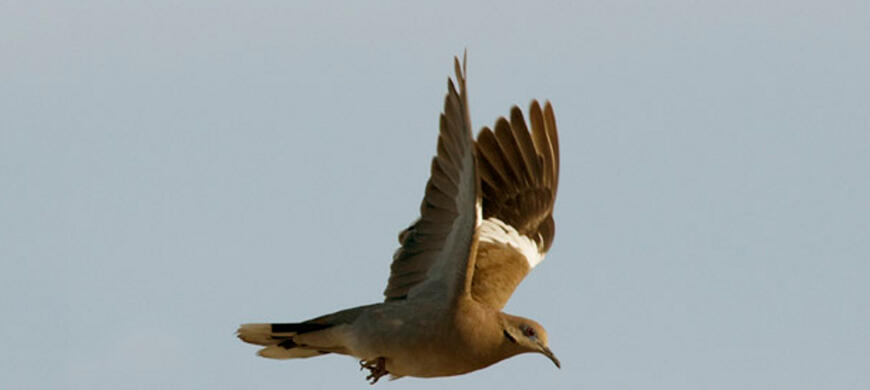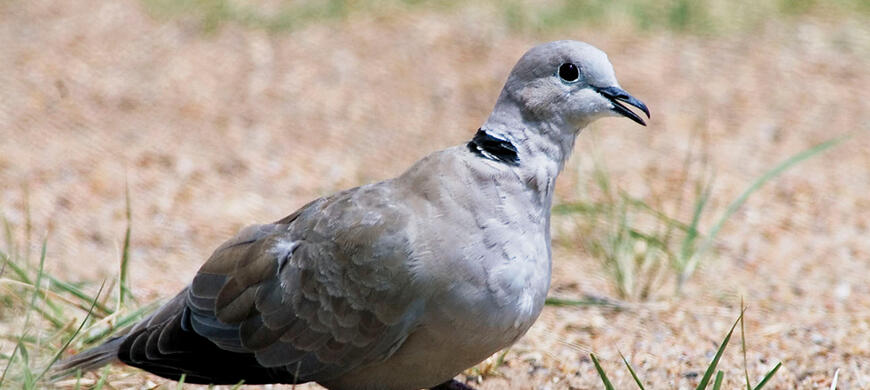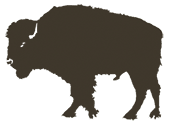Dove



To buy your HIP Stamp online, CLICK HERE.
Four species of doves are legal to hunt in Kansas: mourning dove, Eurasian collared-dove, ringed turtle-dove, and white-winged dove. Pigeons, also known as rock doves or rock pigeons, are classified as a pest species, not a game species, and can be shot year-round.
Mourning and white-winged doves are native to North America, while Eurasian collared- and ringed turtle- doves were introduced. Of these four species, white-winged doves are the largest, followed by Eurasian collared-, ringed turtle-, and mourning doves. Mourning doves have a pointed tail, whereas the other three species have rounded tails. As their name implies, white-winged doves have a large, white wing patch.
Mourning doves are one of the most common bird species in North America. They are hunted in 39 of the 48 conterminous states and their harvest exceeds that of all other migratory game birds (ducks, geese, swans, cranes, rails, woodcock, and snipe) combined. Currently, Kansas is participating in a nationwide mourning dove banding study. Hunters are asked to check their doves for leg bands and if found, report them to the Bird Banding Lab (1-800-327-BAND, www.pwrc.usgs.gov).
Kansas typically has one of the highest breeding indices for mourning doves in the U.S., as measured by the annual Call Count Survey in May. Mourning doves nest in trees, shrubs, and on the ground in crop fields and grasslands. A mourning dove pair can produce up to 3-4 broods of two young per year in Kansas.
Although most mourning doves migrate south by October, many remain in Kansas throughout the fall and some throughout the winter. Kansas’ dove harvest is in the top five in the U.S. Doves in Kansas are primarily hunted in harvested grain fields (particularly sunflowers and millet) and small water holes or windmill ponds in pastures. Some KDWP wildlife areas, mainly in the southeastern and southcentral portions of the state, manage some crop fields for dove hunting.
The Eurasian collared-dove is a native of Europe and Asia. It was accidentally introduced to the Bahamas in the early 1970s when some birds in a pet store were released. By 1996, collared doves had reached Kansas. Collared doves are very similar in appearance to ringed turtle-doves and these two species apparently interbreed. Ringed turtle-doves, however, are more dependent on humans than collared doves. Because these two species are so similar in appearance, most people assume that all light-colored doves with a partial black ring across the back of the neck are Eurasian collared-doves. Thus, there is little distribution information for ringed turtle-doves and the hybrids of these species. In Kansas, collared doves have been reported throughout Kansas in all but eight counties. However, hunters are not likely to shoot one because they tend to stay close to towns, where shooting is not permitted.
Historically, the white-winged dove was a native of Mexico and the southwestern portion of the U.S. and was rarely seen in Kansas. During the past 10 years, numbers of whitewing sightings in Kansas have increased substantially and have been reported in 36 counties. Although white-winged doves are more rural than Eurasian collared-doves and ringed turtle-doves, hunters are unlikely to encounter them because their densities are much lower and sightings tend to occur more in spring and summer than in fall.
Dates: 01/01/2025 - 12/31/2025
(Eurasian collared and ringed turtle doves)
- Area open: Statewide
- Season: Year-round
- Daily bag limit: There is no limit on Eurasian collared or ringed turtle doves, but any taken during the migratory dove season in addition to the mourning and white-winged dove daily bag must have a fully-feathered wing attached while being transported.
Dove Banding Study
Since 2003, biologists in Kansas and 40 other states have banded mourning doves in what has become an ongoing project. The objectives of the banding project are to estimate annual harvest rates (percent of the population shot by hunters) and survival rates (percent of the population surviving one year), and provide information on the geographical distribution of the harvest. In combination with estimates of total harvest from the HIP (Harvest Information Program) survey, banding data can also be used to estimate the size of the mourning dove population. These estimates can be used to monitor trends in mourning dove numbers. This information is needed because mourning doves are such an important migratory game bird and more information is needed to better guide harvest-management decisions. Information on dove survival and harvest rates are keys to understanding the effects of annual hunting regulations on mourning dove populations. Banding is the primary tool used to obtain this information.
Doves are marked with metal leg bands containing a unique number and a toll free 1-800 telephone number and an internet address that hunters can use to report the band. In return, wildlife managers receive important information on the number of banded doves harvested and location and date of harvest. To date, over 11,000 doves have been banded in Kansas and over 300 Kansas-banded doves have been shot by hunters and reported to the Bird Banding Lab. Over 70% of these doves were shot in Kansas..
In Kansas, mourning doves are captured in wire ground traps baited with millet, sunflower, or safflower seeds. Doves enter the trap through the funnels in search of the grain, but cannot get out because of the trap’s design. Traps are checked regularly and trapped doves are removed and carefully examined to determine their age and sex based upon feather color and patterns of feather replacement and wear. Doves are then banded with U.S. Fish and Wildlife Service bands inscribed with unique numbers, the 1-800 telephone number, and an internet address and immediately released.
The hunter is a critical link in this mourning dove banding study. By checking all harvested doves for bands, and reporting banded doves, you help us manage this important migratory game bird resource. Because dove bands are very small, hunters can easily overlook them. We are asking dove hunters to carefully check all doves harvested for the presence of a leg band. If you harvest a banded mourning dove, please call 1-800-327-BAND (2263) or go to the Bird Banding Laboratory website. Hunters can keep the band and will be provided a certificate identifying the age, sex, date, and location the bird was banded.
Beginning in 2023, a map of fields managed for dove hunting by Kansas Department of Wildlife and Parks can be accessed at: https://experience.arcgis.com/experience/1d6b4f5586bc4cc2a30cf412205a7607.
This same mapping information can also be found as an available layer on the online hunting atlas, here: https://ksdot.maps.arcgis.com/apps/webappviewer/index.html?id=a6467b7c4f714053ab63003607674413
To purchase your HIP Stamp online, CLICK HERE.
Migratory Game Bird Hunters – Why is it important to be “HIP”?
If you hunt doves, ducks, geese, sandhill cranes, coots, snipe, rail, or woodcock, you are required to participate in Harvest Information Program (HIP).
What is HIP?
Harvest Information Program (HIP) is a method by which state wildlife agencies and the U.S. Fish and Wildlife Service (USFWS) use to provide reliable estimates of the number of migratory game bird hunters, hunter activity and migratory game bird harvest. These estimates provide information needed to make sound decisions concerning hunting seasons, bag limits, and population management. HIP has been a federal requirement of those hunting migratory game birds since 1998.
Who needs to be HIP?
HIP, incorrectly, has become associated more closely with waterfowl hunters. HIP applies to all those who hunt any species of migratory game birds. This would include not only ducks and geese but also doves, woodcock, rails, snipe, sandhill cranes, moorhens, band-tailed pigeons, swans, brant, coots and gallinules, for which there is a set hunting season. If you are required to buy a Kansas hunting license and plan to hunt any migratory game birds in Kansas, you are required to acquire a Kansas Harvest Information Program (HIP) permit. Even if you hold a lifetime license, you still are required to acquire a HIP permit. Exemptions from HIP include those not required to have a Kansas hunting license such as people hunting their own land and residents 15 and younger and 75 and older. It is the hunter responsibility to fulfill their HIP requirement. Proof of HIP must be carried with the hunter in the field, and, like a hunting or fishing license, must be presented to a wildlife officer upon their request. Hunting migratory birds without HIP certification is like hunting without a license—you could be ticketed or fined. You must be HIP certified for each state for which you hunt migratory game birds. The HIP certification process varies from state to state. Please confer with your local wildlife agency regarding HIP in their state.
How does HIP work?
When you purchase your Kansas HIP permit, you first are identifying yourself as migratory game bird hunter. Secondly, the licensing vendor will ask you a series of short questions relating to your hunting experience during last year's season. These questions place you in a sampling stratum from which the USFWS selects small sample to complete a more detailed survey about this year’s upcoming hunting season. These short questions that you are asked about last year’s hunting experience when you become HIP-certified are not part of the survey, and are not used to compile harvest estimates, but are simply used to identify what types of birds you usually hunt. This allows the USFWS to target its surveys to the appropriate hunters. For example, most surveys about dove harvest are sent to hunters who usually hunt doves, while most waterfowl harvest surveys are sent to hunters who usually hunt ducks and/or geese. If you only hunt ducks and geese – no snipe or rails, no moorhens or gallinules – why is it that I have to answer questions about those species? The USFWS needs to be able to contact people who hunt various birds. This narrows the field and allows the USFWS to ask more detailed questions about what was harvested.
If your name is one of the few selected for the national harvest survey, you will receive a personal letter and a hunting record form and will be asked to voluntarily keep a record of the number of migratory birds you harvest during the season. You will be given an addressed, postage-paid envelope to return your hunting form at the end of the season. This survey provides the information used to develop nationwide harvest estimates for all migratory birds. A few select participants are asked to send in wings of migratory game birds they harvest to help determine species, age, sex, and other important harvest data. All HIP responses are kept strictly confidential and are not used for any other purpose. As soon as the survey is completed, the USFWS destroys all hunter names and address records.
As HIP information is gathered at the time a hunting license is purchased whether at a store or online. At the license counter, the license agent should ask the HIP questions as part of the licensing process; if they do not inquire, you should remind them of HIP’s requirement. Kansas charges a small fee to cover administrative costs. KDWP or USFWS receives no income from this program. HIP is strictly to gather information and is not a means of raising money for conservation programs.
What do hunters gain from HIP?
An understandable question is ‘What does HIP mean to me, as an individual asked to participate in this annual series of inquiries?’ The vast majority of hunters who participate are doing so because they know it’s important and understand why it’s important as hunters. Hunters are not just people answering a survey but are partners in data collection that directly affects hunting opportunities. As the threats and concerns for migratory bird populations continue to mount, it is essential to gather the best information possible about the factors affecting these populations. It is in the hunter's best interest to have wildlife management decisions based on scientific evidence, not on opinions, philosophies, or politics. It only takes a few moments to give wildlife managers the information they need to ensure that our migratory bird resources--and hunting tradition--will be around for future generations to enjoy.
To Purchase Your Kansas HIP Permit Online: https://license.gooutdoorskansas.com
For More Information
USFWS HIP: https://www.fws.gov/birds/surveys-and-data/harvest-surveys/harvest-information-program.php
USFWS Harvest and Hunter Survey Annual Reports: https://www.fws.gov/birds/surveys-and-data/reports-and-publications/hunting-activity-and-harvest.php
Explore Harvest Data visualization for your region: https://fws.gov/harvestsurvey/harvest-vis
Central Flyway Council: https://centralflyway.org/management/harvest-surveys/












